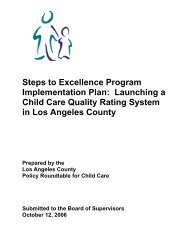STRATEGIC FINANCING: - National Academy for State Health Policy
STRATEGIC FINANCING: - National Academy for State Health Policy
STRATEGIC FINANCING: - National Academy for State Health Policy
Create successful ePaper yourself
Turn your PDF publications into a flip-book with our unique Google optimized e-Paper software.
their investments in children and families will pay off in meaningful and measurable ways.<br />
This means not only by making services available but also by improving results among those<br />
who receive them. Just like business investors, those investing in human services want to<br />
know and be able to measure the return on their investment. They want to see healthier<br />
children, stronger families and safer communities. Financing needs to be aligned with these<br />
types of results, and investment opportunities need to be evaluated in terms of their potential<br />
to reduce the cost of bad results. Bad results create greater costs through remediation,<br />
incarceration, and dependency. When compared to these bad results, investment<br />
opportunities are able to deliver attractive returns.<br />
Guard against supplantation. Often, the implementation of new revenue sources becomes an<br />
opportunity <strong>for</strong> state legislators and county commissioners to “free up” General Fund dollars<br />
<strong>for</strong> other purposes, a term called supplantation. The SECCS guidance, like other new<br />
initiatives, is intended to discourage supplantation. However, many states will face the<br />
reality of General Fund spending levels that do not always keep pace with rising costs or<br />
growing needs. Under these conditions, state and county leaders may choose to not continue<br />
traditional funding levels <strong>for</strong> early childhood programs that have new revenues and improved<br />
financing strategies. Initiative leaders should plan proactive measures to keep the critical<br />
federal, state, and even local funds in place to meet the ongoing needs of young children and<br />
their families.<br />
Keys to Successful Financing<br />
The financing strategies described in the next section do not stand alone and are not ends in<br />
themselves. All financing strategies are a means of achieving desired ends, which in this case<br />
includes increased efficiency in the use of resources and the development of more integrated and<br />
responsive system of early childhood supports and services. Thus, these strategies must be<br />
developed within the context of larger planning processes that focuses on the strategic use of<br />
resources to achieve desired results. Leaders interested in implementing strategic financing<br />
strategies, whether they are operating at the program, community, city, county, or state level, will<br />
be more successful if they lay the groundwork by taking the following steps.<br />
Develop leadership and a clear vision. Attempting to blend separate funding streams is<br />
fundamentally about bridging the differing philosophies and priorities that led to the creation<br />
of categorical streams in the first place. A critical starting point, there<strong>for</strong>e, is the possession<br />
of a clear vision and leadership that can articulate that vision and inspire stakeholders to<br />
achieve it. Once leaders have articulated a clear vision of what they want to achieve, they can<br />
consider their resource options and how they can coordinate or integrate funding streams to<br />
achieve their goals.<br />
Focus on results. Successful financing strategies frequently involve a new commitment to<br />
achieving results. In effect, a focus on process (i.e., who is served with what particular<br />
services) is replaced with a focus on results (i.e., what we—as a program, a community, a<br />
state—are trying to achieve <strong>for</strong> young children and their families). Within this framework,<br />
the use of funding streams can be organized around the supports and services that will most<br />
effectively achieve desired results. Forging clear and agreed-upon desired outcomes <strong>for</strong><br />
young children among the many stakeholders at a number of levels (program, community,<br />
and state) will lay the groundwork <strong>for</strong> a strategic financing strategy.<br />
10

















